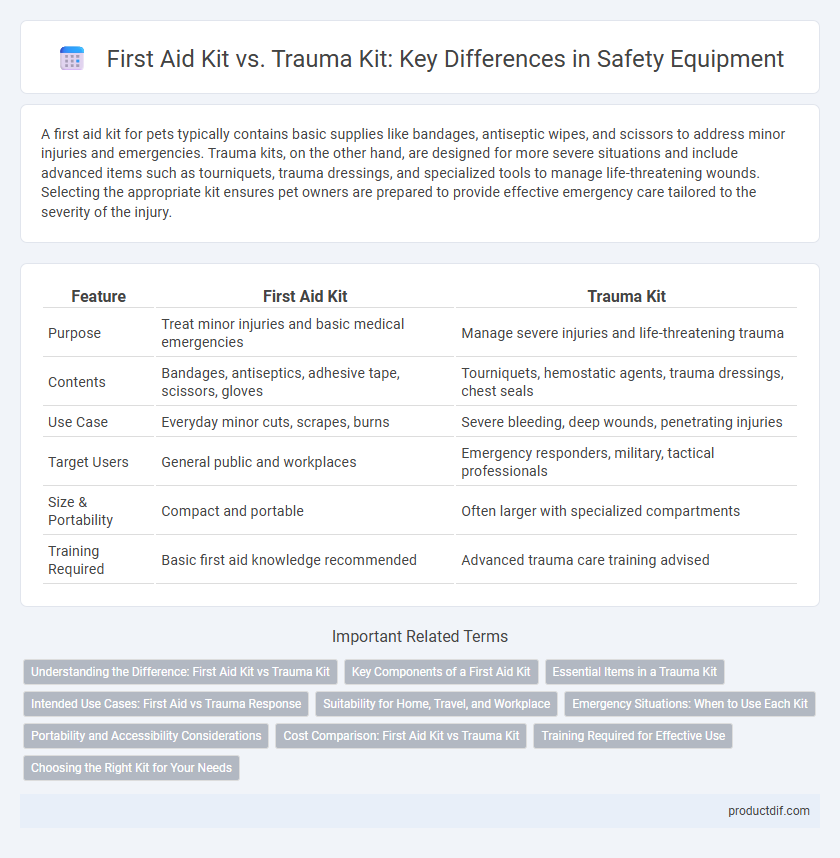A first aid kit for pets typically contains basic supplies like bandages, antiseptic wipes, and scissors to address minor injuries and emergencies. Trauma kits, on the other hand, are designed for more severe situations and include advanced items such as tourniquets, trauma dressings, and specialized tools to manage life-threatening wounds. Selecting the appropriate kit ensures pet owners are prepared to provide effective emergency care tailored to the severity of the injury.
Table of Comparison
| Feature | First Aid Kit | Trauma Kit |
|---|---|---|
| Purpose | Treat minor injuries and basic medical emergencies | Manage severe injuries and life-threatening trauma |
| Contents | Bandages, antiseptics, adhesive tape, scissors, gloves | Tourniquets, hemostatic agents, trauma dressings, chest seals |
| Use Case | Everyday minor cuts, scrapes, burns | Severe bleeding, deep wounds, penetrating injuries |
| Target Users | General public and workplaces | Emergency responders, military, tactical professionals |
| Size & Portability | Compact and portable | Often larger with specialized compartments |
| Training Required | Basic first aid knowledge recommended | Advanced trauma care training advised |
Understanding the Difference: First Aid Kit vs Trauma Kit
A first aid kit contains basic medical supplies such as bandages, antiseptics, and scissors designed for treating minor injuries like cuts, scrapes, and burns. A trauma kit provides advanced emergency gear including tourniquets, chest seals, and hemostatic dressings intended for severe injuries caused by accidents or violent incidents. Understanding the difference between a first aid kit and a trauma kit ensures proper preparedness for varying levels of medical emergencies.
Key Components of a First Aid Kit
First aid kits typically contain essential supplies such as adhesive bandages, antiseptic wipes, gauze pads, medical tape, scissors, and gloves designed for treating minor injuries and preventing infection. In contrast, trauma kits include specialized components like tourniquets, hemostatic agents, chest seals, and trauma shears for managing severe wounds and life-threatening emergencies. Understanding the key components of a first aid kit ensures preparedness for common injuries in everyday situations.
Essential Items in a Trauma Kit
A trauma kit contains essential items such as hemostatic dressings, tourniquets, chest seals, and advanced airway management tools designed to address severe injuries and control life-threatening bleeding. Unlike basic first aid kits that include bandages, antiseptics, and adhesive tape, trauma kits are specifically equipped to manage critical trauma situations in emergencies. These specialized supplies are vital for first responders and trauma care providers to stabilize patients before professional medical treatment.
Intended Use Cases: First Aid vs Trauma Response
First aid kits are designed for basic medical emergencies such as minor cuts, burns, and sprains, providing essential supplies like bandages, antiseptics, and pain relievers. Trauma kits are specialized for severe injuries often seen in high-risk environments, containing advanced equipment such as tourniquets, hemostatic dressings, and chest seals to manage life-threatening bleeding and trauma. Understanding the distinction in intended use cases ensures proper preparedness for routine first aid versus critical trauma response scenarios.
Suitability for Home, Travel, and Workplace
First aid kits are ideal for home and travel use, containing basic supplies to manage minor injuries and common medical emergencies. Trauma kits are specifically designed for workplaces with higher risk environments, offering advanced tools and supplies for severe injuries like heavy bleeding and fractures. Choosing between a first aid kit and a trauma kit depends on the setting's risk level and the likelihood of encountering life-threatening injuries.
Emergency Situations: When to Use Each Kit
A first aid kit is designed for minor injuries such as cuts, scrapes, and burns, making it ideal for everyday emergencies and small accidents. Trauma kits contain advanced supplies like tourniquets, hemostatic dressings, and chest seals, which are essential for severe injuries including major bleeding, fractures, and penetrating wounds often encountered in high-risk environments. Choosing the appropriate kit depends on the severity of the injury and the level of medical intervention required during emergency situations.
Portability and Accessibility Considerations
A first aid kit is designed for basic medical emergencies and is generally compact, lightweight, and easy to carry, making it highly portable and accessible for everyday use. Trauma kits are bulkier and contain specialized equipment for severe injuries, requiring strategic placement for quick accessibility in high-risk environments. Choosing between the two depends on the balance of portability needs and the level of emergency preparedness required.
Cost Comparison: First Aid Kit vs Trauma Kit
First aid kits generally cost between $20 and $50, offering basic supplies like bandages, antiseptics, and adhesive tape suitable for minor injuries. Trauma kits are pricier, ranging from $75 to over $200, as they include specialized items such as tourniquets, hemostatic agents, and chest seals designed for severe trauma care. Investing in a trauma kit significantly increases upfront costs but provides enhanced readiness for critical emergencies compared to standard first aid kits.
Training Required for Effective Use
First aid kits require basic training in wound care, CPR, and handling minor injuries to be effective during emergencies. Trauma kits demand advanced training in life-saving techniques such as managing severe bleeding, airway obstruction, and shock stabilization for critical trauma situations. Proper training ensures users can confidently apply the necessary interventions and improve patient outcomes in both minor and severe incidents.
Choosing the Right Kit for Your Needs
Selecting the right safety equipment depends on the specific medical scenarios you anticipate; first aid kits are ideal for everyday minor injuries, containing essentials like bandages, antiseptics, and adhesive tape. Trauma kits offer advanced supplies such as tourniquets, chest seals, and hemostatic agents designed for serious injuries and emergency trauma situations. Evaluating your environment, risk level, and emergency response capability ensures the choice of a first aid kit or trauma kit aligns with your preparedness goals.
First aid kit vs Trauma kit Infographic

 productdif.com
productdif.com